Top 10 Foods Highest in Vitamin C
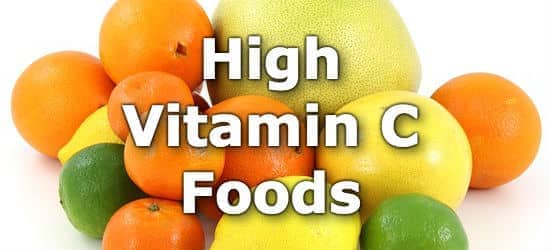
Vitamin C is an essential nutrient required for the maintenance of many body tissues, including skin, blood vessels, bones, and cartilage. Vitamin C is also essential for wound healing. (1,2)
Vitamin C helps protect cells against oxidative stress, which in turn provides protection against certain diseases, including cancer. (1,3)
Vitamin C, like zinc and vitamin A, also helps support your immune system. (4,5,6)
High vitamin C foods include guavas, bell peppers, kiwifruit, strawberries, oranges, papayas, broccoli, tomatoes, kale, and snow peas. The current daily value (DV) for vitamin C is 90mg. (7)
Below is a list of high vitamin C foods ranked by a common serving size. Use the nutrient ranking of over 200 foods high in vitamin C to see the foods highest in vitamin C by nutrient density (per gram), or see rankings of fruits high in vitamin C, and vegetables high in vitamin C.
High Vitamin C Foods
-
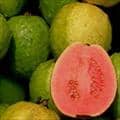 1. Guavas + Add
1. Guavas + Add
Vitamin C
per CupVitamin C
per 100gVitamin C
per 200 Calories377mg
(419% DV)228mg
(254% DV)671mg
(746% DV)See all fruits high in vitamin C.
-
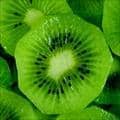 2. Kiwifruit + Add
2. Kiwifruit + Add
Vitamin C
per CupVitamin C
per 100gVitamin C
per 200 Calories167mg
(185% DV)93mg
(103% DV)304mg
(338% DV) -
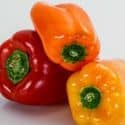 3. Bell Peppers + Add
3. Bell Peppers + Add
Vitamin C
per CupVitamin C
per 100gVitamin C
per 200 Calories152mg
(169% DV)128mg
(142% DV)982mg
(1091% DV)Red bell peppers provide around 50% more vitamin C than green bell peppers. View the complete comparison of green vs red bell peppers.
-
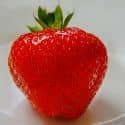 4. Strawberries + Add
4. Strawberries + Add
Vitamin C
per CupVitamin C
per 100gVitamin C
per 200 Calories98mg
(108% DV)59mg
(65% DV)368mg
(408% DV)More Berries High in Vitamin C
- 36% DV in 1 cup of raspberries
- 34% DV in 1 cup of blackberries
- 16% DV in 1 cup of blueberries
See all fruits high in vitamin C.
-
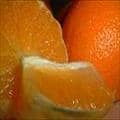 5. Oranges + Add
5. Oranges + Add
Vitamin C
per CupVitamin C
per 100gVitamin C
per 200 Calories96mg
(106% DV)53mg
(59% DV)226mg
(252% DV)More Citrus Fruit High in Vitamin C
- 413% DV in 1 pomelo
- 98% DV in 1 grapefruit
- 40% DV in 1 clementine
- 34% DV in 1 lemon
-
6. Papaya + Add
Vitamin C
per CupVitamin C
per 100gVitamin C
per 200 Calories88mg
(98% DV)61mg
(68% DV)283mg
(315% DV)More Tropical Fruits High in Vitamin C
- 88% DV in 1 cup of pineapple
- 72% DV in 1 cup of cantaloupe melon
- 67% DV in 1 cup of sliced mango
- 34% DV in 1 cup of honeydew melon
See all fruits high in vitamin C.
-
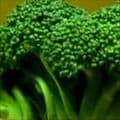 7. Broccoli + Add
7. Broccoli + Add
Vitamin C
per CupVitamin C
per 100gVitamin C
per 200 Calories81mg
(90% DV)89mg
(99% DV)525mg
(583% DV)More Brassica Vegetables High in Vitamin C
- 107% DV in 1 cup of brussels sprouts
- 61% DV in 1 cup of cauliflower
- 63% DV in 1 cup of cabbage
See all vegetables high in vitamin C.
-
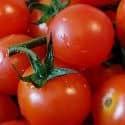 8. Tomato + Add
8. Tomato + Add
Vitamin C
per Cup CookedVitamin C
per 100gVitamin C
per 200 Calories55mg
(61% DV)23mg
(25% DV)253mg
(281% DV) -
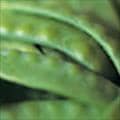 9. Snow Peas + Add
9. Snow Peas + Add
Vitamin C
per CupVitamin C
per 100gVitamin C
per 200 Calories38mg
(42% DV)60mg
(67% DV)286mg
(317% DV) -
10. Kale + Add
Vitamin C
per Cup CookedVitamin C
per 100gVitamin C
per 200 Calories23mg
(26% DV)18mg
(20% DV)99mg
(110% DV)More Green Leafy Vegetables High in Vitamin C
- 44% DV in 1 cup of turnip greens
- 35% DV in 1 cup of Swiss chard
- 20% DV in 1 cup of spinach
See all vegetables high in vitamin C.
Printable One Page Sheet
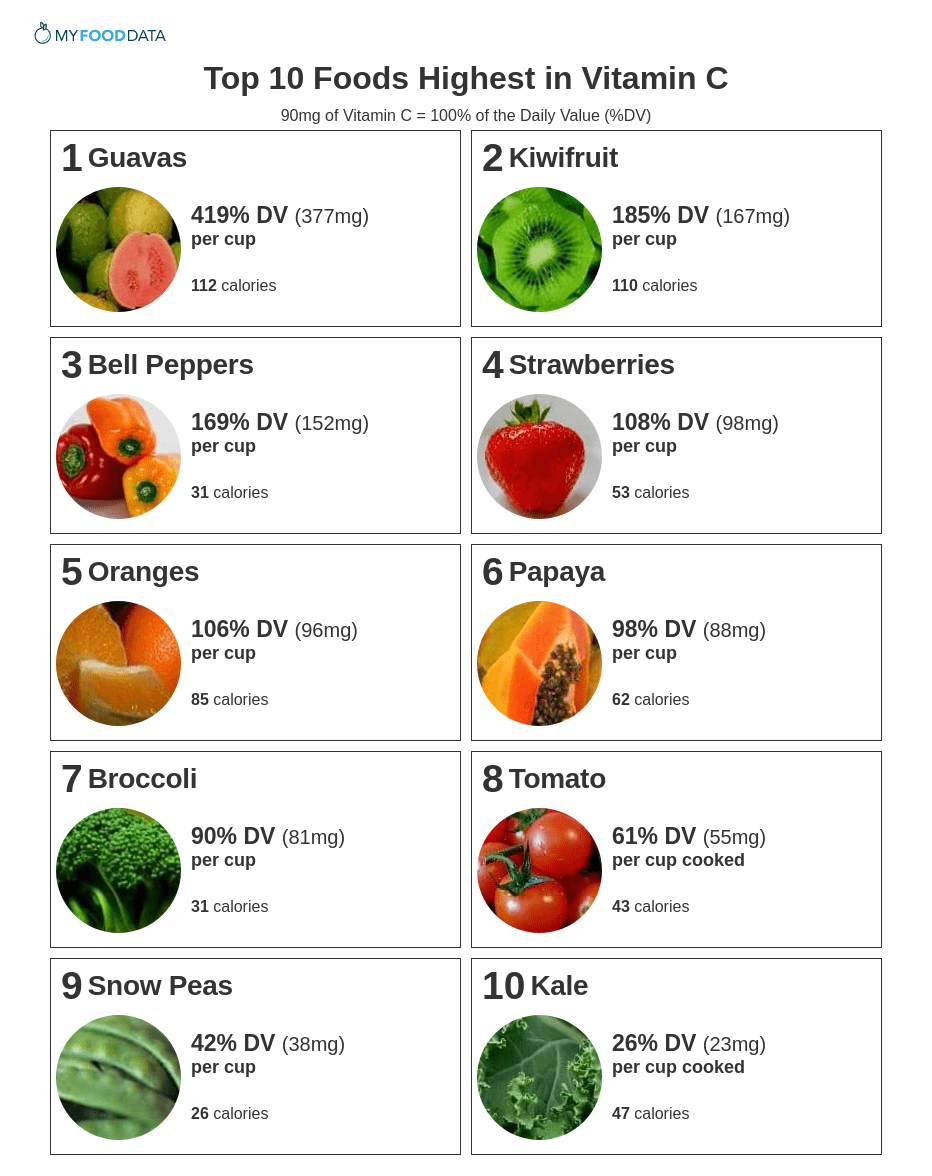
Vitamin C Foods by Nutrient Density (Vitamin C per Gram)
| Food | Serving | Vitamin C |
|---|---|---|
| 1. Acerola Cherry + | 100 grams | 1864% DV (1678mg) |
| 2. Dried Herbs (Coriander) + | 100 grams | 630% DV (567mg) |
| 3. Rose Hips + | 100 grams | 473% DV (426mg) |
| 4. Guavas + | 100 grams | 254% DV (228mg) |
| 5. Sweet Yellow Peppers + | 100 grams | 204% DV (184mg) |
| 6. Black Currants + | 100 grams | 201% DV (181mg) |
| 7. Thyme + | 100 grams | 178% DV (160mg) |
| 8. Red Chilies + | 100 grams | 160% DV (144mg) |
| 9. Scotch Kale + | 100 grams | 144% DV (130mg) |
| 10. Kiwifruit + | 100 grams | 103% DV (93mg) |
Other Vitamin C Rich Foods
| Food | Serving | Vitamin C |
|---|---|---|
| 1. Litchis (Lychees) + | per cup | 151% DV (136mg) |
| 2. Green Chillies + | 1 pepper | 121% DV (109mg) |
| 3. Kohlrabi + | 1 cup | 93% DV (84mg) |
| 4. Parsley + | per cup | 89% DV (80mg) |
| 5. Orange Juice + | per 8oz cup | 80% DV (72mg) |
| 6. Bitter Melon + | per cup | 45% DV (41mg) |
| 7. Starfruit (Carambola) + | per cup | 41% DV (37mg) |
| 8. Garden Cress + | 1 cup | 38% DV (35mg) |
| 9. Jalapeno Peppers + | 1 pepper | 18% DV (17mg) |
| 10. Saffron + | 1 tbsp | 2% DV (2mg) |
Vitamin C Requirements By Age and Gender
The recommended daily allowance (RDA) for Vitamin C ranges from 15mg to 120mg per day. The daily value for vitamin C is 90mg per day. (7)
| Life Stage | RDA |
|---|---|
| Infants* | |
| 0-6 months old | 40mg |
| 7-12 months old | 50mg |
| Children | |
| 1-3 years old | 15mg |
| 4-8 years old | 25mg |
| Males | |
| 9-13 years old | 45mg |
| 14-18 years old | 75mg |
| 19-50 years old | 90mg |
| 50+ years old | 90mg |
| Females | |
| 9-13 years old | 45mg |
| 14-18 years old | 65mg |
| 19-50 years old | 75mg |
| 50+ years old | 75mg |
| Pregnancy | |
| 14-18 years old | 80mg |
| 18+ years old | 85mg |
| Lactation | |
| 14-18 years old | 115mg |
| 18+ years old | 120mg |
Source: Dietary Reference Intakes for Vitamin C.
From the Nutrient Ranking Tool
Use the ranking tool links below to select foods and create your own food list to share or print.
- Foods High in Vitamin C
- Foods Low in Vitamin C
- Vegetables High in Vitamin C
- Fruits High in Vitamin C
- Vegetarian Foods High in Vitamin C
- Nuts High in Vitamin C
- Beans High in Vitamin C
- Dairy High in Vitamin C
- Breakfast Cereals High in Vitamin C
- Fast Foods High in Vitamin C
View more nutrients with the nutrient ranking tool, or see ratios with the nutrient ratio tool.
Related
Data Sources and References
- Lane DJ, Chikhani S, Richardson V, Richardson DR. Mitochondria, Energy and Cancer: The Relationship with Ascorbic Acid Biochim Biophys Acta. 2013 Jun;1833(6):1527-41. doi: 10.1016/j.bbamcr.2013.02.010. Epub 2013 Feb 26. 23481043
- Sinclair PR, Gorman N, Shedlofsky SI, Honsinger CP, Sinclair JF, Karagas MR, Anderson KE. Role of Vitamin C in Skin Diseases J Lab Clin Med. 1997 Aug;130(2):197-201. doi: 10.1016/s0022-2143(97)90096-2. 9280147
- Wu SJ, Ng LT, Lin CC. L-ascorbic acid (vitamin C) induces the apoptosis of B16 murine melanoma cells via a caspase-8-independent pathway Eur J Pharmacol. 2005 Aug 22;518(2-3):96-106. doi: 10.1016/j.ejphar.2005.06.021. 16054126
- Ströhle A, Wolters M, Hahn A. Vitamin C and Immune Function Inflamm Allergy Drug Targets. 2011 Feb;10(1):54-63. doi: 10.2174/187152811794352105. 21184650
- Yamamoto M. The role of vitamin A and related retinoids in immune function World Rev Nutr Diet. 1991;64:58-84. doi: 10.1159/000418570. 2028624
- Prasad AS. Zinc in human health: effect of zinc on immune cells Exp Gerontol. 2008 May;43(5):370-7. doi: 10.1016/j.exger.2007.10.013. Epub 2007 Nov 1. 18054190
- U.S.FDA - Daily Value on the New Nutrition and Supplement Facts Labels
Simplify Nutrition Tracking with MyFoodData!
Speedy Tools and Detailed Data FREEEasily analyze your meals to find the best foods for your goals.
✅ Use our recipe nutrition calculator and nutrition comparison tool.
✅ Access expert nutrition data tools and in-depth articles.
✅ Log foods and organize your recipes with a free account.


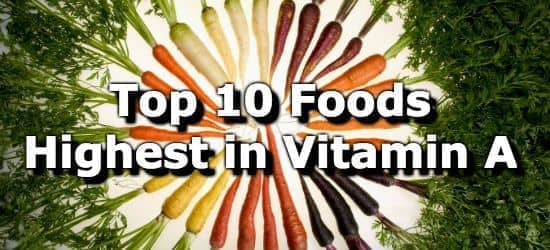 Next ➞
Next ➞
